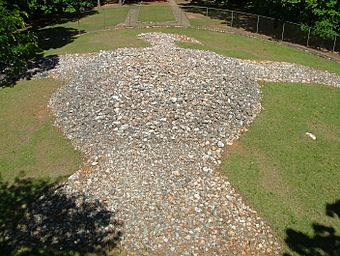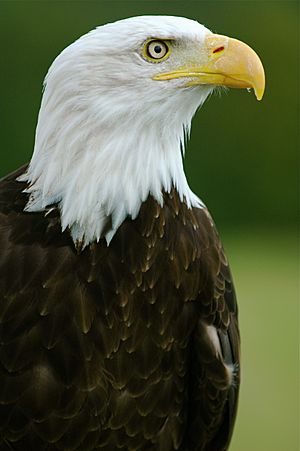Rock Eagle facts for kids
Quick facts for kids |
|
|
Rock Eagle Site
|
|

Rock Eagle Effigy Mound, viewed from adjacent observation tower, August 26, 2007
|
|
| Lua error in Module:Location_map at line 420: attempt to index field 'wikibase' (a nil value). | |
| Nearest city | Eatonton, Georgia |
|---|---|
| NRHP reference No. | 78001001 |
The Rock Eagle Effigy Mound is an amazing ancient site in Putnam County, Georgia, USA. It's a huge shape of a bird made from thousands of rocks. Experts believe it was built between 1,000 and 3,000 years ago.
This giant bird is 102 feet long from its head to its tail. Its wings stretch out 120 feet from tip to tip. Most people call it an eagle, but no one knows for sure what kind of bird the ancient builders wanted to show. This special place is listed on the National Register of Historic Places (NRHP) because it's so important. The University of Georgia helps take care of the site. They also use the land nearby for a 4-H camp. Here, kids learn about nature and the environment.
The people who lived in Middle Georgia long ago built these huge bird shapes. It's still a bit of a mystery why they created them. These mounds likely had a special meaning for ceremonies. The Rock Eagle mound seems to have grown from a large, round mound in the center.
Contents
Discovering the Rock Eagle Mound
Only two large bird shapes made of earth have been found east of the Mississippi River. The other one, called Rock Hawk, is also in Putnam County. It is about thirteen miles southeast of Rock Eagle.
At first, people thought Rock Eagle was as old as 5,000 years. We know that Archaic Indians lived in this area back then. However, experts now believe they didn't build the mound. Today, archaeologists think the mound was built by Woodland Indians. This was between 1,000 and 3,000 years ago. These Native Americans might have been part of the Adena or Hopewell groups. But it's more likely they were a unique group of people. The Rock Eagle is the second oldest Indian mound in Georgia. The Sapelo Shell Ring Complex is the oldest.
Early settlers in the area thought the mound might hide treasure. So, they dug into it sometimes. But in the 1900s, archaeologists found something different. They discovered the eagle was built on top of a natural rock hill. People have different ideas about why it was built. Some think it was a burial place for ancient people. Others believe the builders were sending a message to their gods.
The mound shows a bird with a big beak and a fan-shaped tail. In 1877, archaeologist Charles C. Jones measured it. He found it was 120 feet from head to tail and 102 feet from wingtip to wingtip. Many say the bird's head faces east. They think it faces the rising sun, which might have been important for their beliefs. However, the head actually faces south by southeast. Its beak points almost directly south. The rocks forming the bird's chest are piled high, about eight to ten feet. The wings, tail, and head are not as high. Archaeologists found clay on the mound that wasn't from the local area. This suggests that materials were brought from other places to build it.
Early archaeologists also found signs of human burials on the mound. They also found a projectile point, which is like an arrowhead. Some experts think the mound looks more like a buzzard or vulture than an eagle. The buzzard was a symbol of death for some Native American groups. So, it would make sense for it to be a burial mound. Rock Eagle is known as a burial site.
Studying the Rock Eagle
Scientists started studying the Rock Eagle Effigy Mound in 1877. Dr. Vincenzo Petrullo, a famous archaeologist, published the first measurements. Later, in the 1930s, University of Georgia archaeologist A. R. Kelly dug up much of the site. From his work, a few human and animal bones were found. A projectile point was also found, but it's not clear if it was related to the effigy. Over the years, archaeologists have found very few artifacts inside the mound. They mostly found the stones it was made from. In the 1950s, a project found a single quartz tool at Rock Eagle. They also found evidence of human burials that had been cremated. Other than that, the mound hasn't revealed much about its purpose.
The land was sold to the United States government by Florence Scott. In the 1930s, the Works Progress Administration (WPA) built a granite tower. They worked with the University of Georgia on this project. This tower lets visitors see the mound from above. In 1954, Kelly reported that both Rock Eagle and Rock Hawk seemed to have been surrounded by a wall of rocks. These rocks were similar to those used to build the effigies. This might connect them to similar walls found at Stone Mountain and Fort Mountain. The site has been carefully restored. Plants were removed from the mound, and scattered rocks were put back in place. The mound rises 10 feet above the ground. It is made of thousands of small to medium-sized rocks.
The stone tower was built by workers in the 1930s. It gives an amazing view of the Rock Eagle. It's a great place to visit, even though the stairs can be a bit tiring. A paved path goes around the bird shape. There are signs along the path that explain the site's history. The park is kept very clean and beautiful. The U.S. Department of the Interior added Rock Eagle to the National Register of Historic Places in 1987.
You can't walk on the mound itself. A tall fence surrounds the site to protect it. The University of Georgia manages the site. They use the land nearby for a 4-H camp. This camp has cottages and other buildings. It offers day and overnight environmental education programs. Visitors can see the mound for free. The site is located next to State Route 441. It is between the towns of Madison and Eatonton. The park covers 1500 acres in total.
Bronze Marker at the Site
In 1940, a state heritage group placed a bronze marker near the head of the bird shape. This marker helps tell visitors about the site's history.
Rock Eagle's Influence
The Rock Eagle 4-H Center next to the mound is named after it. The center even uses a picture of the mound on its newsletter, called Wingspan.
Gallery
- Rock Eagle Effigy Mound
-
Bronze marker at the effigy's head






